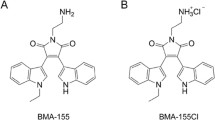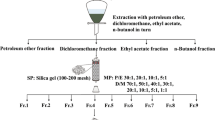Abstract
Previous report showed that leukemia cells’ differentiation could be induced by retinoic acid (RA), and prostate cancer cells’ proliferation could be inhibited by Vitamin D or its analog. This study aimed to examine whether RA and vitamin D analog EB1089 have synergistic effect on hepatocellular cancer cells’ apoptosis. The hepatocellular cancer cell lines’ viability was determined by MTT method after treating by RA and EB1089 alone or in combination, cell cycle of SSMC-7721 cell analyzed by FACS, mitochondrial membrane potential of SSMC-7721 under different treatments were detected using MitoTracker Red CMXRos. TUNEL analysis was also used for cell apoptosis detection. Real time-PCR and Western Blot assay were used to detect the expression of Bcl-2 and Bax. Moreover, hepatocellular cancer model was developed by subcutaneously (S.C.) challenging H22 cells to nude mice. In the combination group (10 μmol/L RA, 10 nmol/L EB1089), the viability of hepatocellular cancer cells decreased significantly compared with drugs used alone (P < 0.05). From the TUNEL analysis, SSMC-7721 cells have a higher apoptotic ratio in the combined drug group than in the groups for which the drugs were used separately. In a hepatocellular cancer model, the tumor weight of H22 tumor bearing mice was more reduced in the combined drug treated group when compared to the groups for which the drugs were used alone (P < 0.05), in addition, significantly prolonged survival was observed. Combination of RA and EB1089 exert synergistic growth inhibition and apoptosis induction on hepatocellular cancers cells.





Similar content being viewed by others
References
Bettoun DJ, Burris TP, Houck KA, Buck DW 2nd, Stayrook KR, Khalifa B, Lu J, Chin WW, Nagpal S (2003) Retinoid X receptor is a nonsilent major contributor to vitamin D receptor-mediated transcriptional activation. Mol Endocrinol 17:2320–2328
Chiu HJ, Fischman DA, Hammerling U (2008) Vitamin A depletion causes oxidative stress, mitochondrial dysfunction, and PARP-1-dependent energy deprivation. FASEB J 22:3878–3887
Clarke N, Germain P, Altucci L, Gronemeyer H (2004) Retinoids: potential in cancer prevention and therapy. Expert Rev Mol Med 6:1–23
Collins MD, Eckhoff C, Chahoud I, Bochert G, Nau H (1992) 4-Methylpyrazole partially ameliorated the teratogenicity of retinol and reduced the metabolic formation of all-trans-retinoic acid in the mouse. Arch Toxicol 66:652–659
Czeczuga-Semeniuk E, Bielawski T, Lemancewicz D, Rusak M, Wołczyński S (2009) Vitamin A family compounds, estradiol, and docetaxel in proliferation, apoptosis and immunocytochemical profile of human ovary endometrioid cancer cell line CRL-11731. Folia Histochem Cytobiol 47:S127–S135
Elstner E, Campbell MJ, Munker R, Shintaku P, Binderup L, Heber D, Said J, Koeffler HP (1999) Novel 20-epi-vitamin D3 analog combined with 9-cis-retinoic acid markedly inhibits colony growth of prostate cancer cells. Prostate 40:141–149
Engedal N, Auberger P, Blomhoff HK (2009) Retinoic acid regulates Fas-induced apoptosis in Jurkat T cells: reversal of mitogen-mediated repression of Fas DISC assembly. J Leukoc Biol 85:469–480
Gao F, Tang Q, Yang P, Fang Y, Li W, Wu Y (2010) Apoptosis inducing and differentiation enhancement effect of oridonin on the all-trans-retinoic acid-sensitive and -resistant acute promyelocytic leukemia cells. Int J Lab Hematol 32:e114–e122
González-Sancho JM, Larriba MJ, Ordóñez-Morán P, Pálmer HG, Muñoz A (2006) Effects of 1alpha,25-dihydroxyvitamin D3 in human colon cancer cells. Anticancer Res 26:2669–2681
Guzey M, Kitada S, Reed JC (2002) Apoptosis induction by 1 alpha, 25-dihydroxyvitamin D3 in prostate cancer. Mol Cancer Ther 1:667–677
Hou G, Wang QY, Wang XQ, Kang J, Yu RJ (2008) Effects of vitamin A on the proliferation and apoptosis of alveolar cells of experimental emphysema in rats. Zhonghua Jie He He Hu Xi Za Zhi 31:209–212
James SY, Williams MA, Kelsey SM, Newland AC, Colston KW (1997) The role of vitamin D derivatives and retinoids in the differentiation of human leukaemia cells. Biochem Pharmacol 54:625–634
Luo P, Lin M, Lin M, Chen Y, Yang B, He Q (2009) Function of retinoid acid receptor alpha and p21 in all-trans-retinoic acid-induced acute T-lymphoblastic leukemia apoptosis. Leuk Lymphoma 50:1183–1189
McGrath J (2001) Does ‘imprinting’ with low prenatal vitamin D contribute to the risk of various adult disorders? Med Hypotheses 56:367–371
Muto A, Kizaki M, Yamato K, Kawai Y, Kamata-Matsushita M, Ueno H, Ohguchi M, Nishihara T, Koeffler HP, Ikeda Y (1999) 1,25-Dihydroxyvitamin D3 induces differentiation of a retinoic acid-resistant acute promyelocytic leukemia cell line (UF-1) associated with expression of p21(WAF1/CIP1) and p27(KIP1). Blood 93:2225–2233
Ng KY, Ma MT, Leung KK, Leung PS (2010) Vitamin D and vitamin A receptor expression and the proliferative effects of ligand activation of these receptors on the development of pancreatic progenitor cells derived from human fetal pancreas. Stem Cell Rev. (Epub ahead of print)
Papi A, Rocchi P, Ferreri AM, Guerra F, Orlandi M (2009) Enhanced effects of PPAR gamma ligands and RXR selective retinoids in combination to inhibit migration and invasiveness in cancer cells. Oncol Rep 21:1083–1089
Park JS, Koh YS, Bang JY, Jeong YI, Lee JJ (2008) Antitumor effect of all-trans retinoic acid-encapsulated nanoparticles of methoxy poly(ethylene glycol)-conjugated chitosan against CT-26 colon carcinoma in vitro. J Pharm Sci 97:4011–4019
Pérez-López FR, Chedraui P, Haya J (2009) Review article: vitamin D acquisition and breast cancer risk. Reprod Sci 16:7–19
Pettersson F, Colston KW, Dalgleish AG (2000) Differential and antagonistic effects of 9-cis-retinoic acid and vitamin D analogues on pancreatic cancer cells in vitro. Br J Cancer 83:239–245
Popadic S, Ramic Z, Medenica L, Mostarica Stojkovic M, Trajković V, Popadic D (2008) Antiproliferative effect of vitamin A and D analogues on adult human keratinocytes in vitro. Skin Pharmacol Physiol 21:227–234
Sadikoglou E, Magoulas G, Theodoropoulou C, Athanassopoulos CM, Giannopoulou E, Theodorakopoulou O, Drainas D, Papaioannou D, Papadimitriou E (2009) Effect of conjugates of all-trans-retinoic acid and shorter polyene chain analogues with amino acids on prostate cancer cell growth. Eur J Med Chem 44:3175–3187
Spina CS, Tangpricha V, Uskokovic M, Adorinic L, Maehr H, Holick MF (2006) Vitamin D and cancer. Anticancer Res 26:2515–2524
Stefanska B, Salamé P, Bednarek A, Fabianowska-Majewska K (2012) Comparative effects of retinoic acid, vitamin D and resveratrol alone and in combination with adenosine analogues on methylation and expression of phosphatase and tensin homologue tumour suppressor gene in breast cancer cells. Br J Nutr 107:781–790
Wang ZY, Chen Z (2008) Acute promyelocytic leukemia: from highly fatal to highly curable. Blood 111:2505–2515
Wang S, Hu CP, Jiang DJ, Peng J, Zhou Z, Yuan Q, Nie SD, Jiang JL, Li YJ, Huang KL (2009) All-trans retinoic acid inhibits cobalt chloride-induced apoptosis in PC12 cells: role of the dimethylarginine dimethylaminohydrolase/asymmetric dimethylarginine pathway. J Neurosci Res 87:1938–1946
Zhang C, Baudino TA, Dowd DR, Tokumaru H, Wang W, MacDonald PN (2001) Ternary complexes and cooperative interplay between NCoA-62/Ski-interacting protein and steroid receptor coactivators in vitamin D receptor-mediated transcription. J Biol Chem 276:40614–40620
Zhang J, Chalmers MJ, Stayrook KR, Burris LL, Wang Y, Busby SA, Pascal BD, Garcia-Ordonez RD, Bruning JB, Istrate MA, Kojetin DJ, Dodge JA, Burris TP, Griffin PR (2011) DNA binding alters coactivator interaction surfaces of the intact VDR-RXR complex. Nat Struct Mol Biol 18:556–563
Zinser GM, McEleney K, Welsh J (2003) Characterization of mammary tumor cell lines from wild type and vitamin D3 receptor knockout mice. Mol Cell Endocrinol 200:67–80
Acknowledgments
The authors have no commercial, proprietary, or financial interest in the products or companies described in this article.
Author information
Authors and Affiliations
Corresponding author
Rights and permissions
About this article
Cite this article
Zhang, J., Zhang, H., Zhang, X. et al. Synergistic effect of retinoic acid and vitamin D analog EB1089-induced apoptosis of hepatocellular cancer cells. Cytotechnology 65, 457–465 (2013). https://doi.org/10.1007/s10616-012-9500-z
Received:
Accepted:
Published:
Issue Date:
DOI: https://doi.org/10.1007/s10616-012-9500-z




